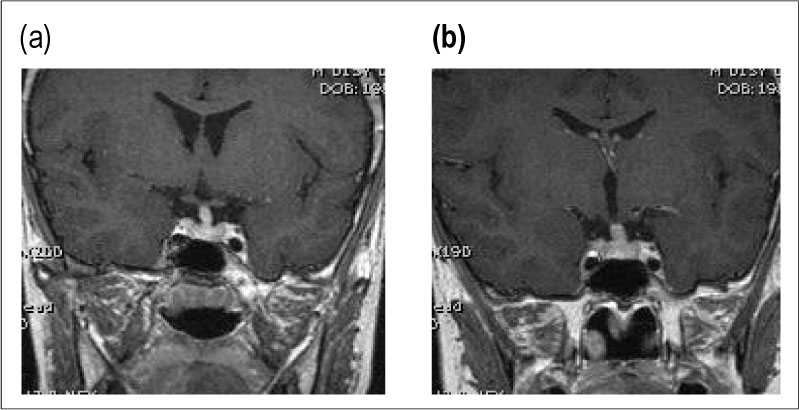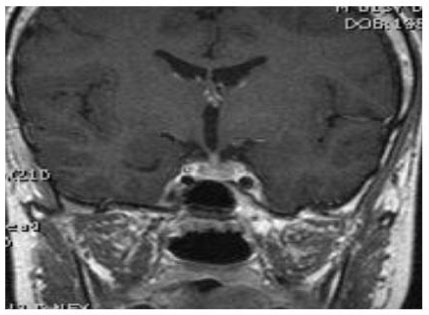J Korean Soc Endocrinol.
2005 Oct;20(5):513-518. 10.3803/jkes.2005.20.5.513.
A Case of Langerhans Cell Histiocytosis Presented with Central Diabetes Insipidus
- Affiliations
-
- 1Department of Internal Medicine, College of Medicine, Chungbuk National University, Cheong-ju, Korea.
- 2Department of Neurosurgey, College of Medicine, Chungbuk National University, Cheong-ju, Korea.
- 3Department of Pathology, College of Medicine, Chungbuk National University, Cheong-ju, Korea.
- KMID: 2200600
- DOI: http://doi.org/10.3803/jkes.2005.20.5.513
Abstract
- Langerhans cell histiocytosis can cause central diabetes insipidus. Here, a case of Langerhans cell histiocytosis invading the pituitary stalk was experienced. The patient was 15 years old boy, with complaint of polydipsia and polyuria. A water deprivation test was carried out, and the urine osmolarity was increased from 165 to 469 mosm/kg following an injection of AVP to confirm the diagnosis of central diabetes insipidus. A pituitary function stimulation test gave a normal response. A sellar MRI was performed, which showed a thickened pituitary stalk mass (about 5.7mm), with an increased size, 6.9 mm, on a second MRI 2 month later. A tissue biopsy was performed, which showed aggregates of histiocytes and inflammatory cells, with prominent eosinophils (H&E), and also revealed strong reactivity to anti-CD1a antibody on the immunohistochemistry. After confirmative tissue diagnosis, the patient received radiotherapy (900 cGy). The thickened mass of the pituitary stalk disappeared on the MRI following the radiotherapy. The patient was managed with DDAVP nasal spray, after which the polyuric symptoms were completely relieved.
MeSH Terms
-
Adolescent
Biopsy
Deamino Arginine Vasopressin
Diabetes Insipidus, Neurogenic*
Diagnosis
Eosinophils
Histiocytes
Histiocytosis, Langerhans-Cell*
Humans
Immunohistochemistry
Magnetic Resonance Imaging
Male
Osmolar Concentration
Pituitary Gland
Polydipsia
Polyuria
Radiotherapy
Water Deprivation
Deamino Arginine Vasopressin
Figure
Reference
-
5. Baumgartner I, von Hochstetter A, Baumert B, Luetolf U, Follath F. Langerhan's cell histiocytosis in adults. Med Ped Oncol. 1997. 28:9–14.6. Malpas JS, Norton AJ. Langerhan's cell histiocytosis in adults. Med Ped Oncol. 1996. 27:540–546.7. Lichtenstein L. Histiocytosis X: intergration of eosinophilic granuloma of the bone, Letterer-Siwe disease and Schuller-Christian disease as related manifestations of a single nosologic entity. Arch Pathol. 1953. 56:84–102.8. Egeler RM, Favara BE, van Meurs M, Laman JD, Claassen E. Differential in situ cytokine profiles of Langerhans-like cells and T cells in Langerhans cell histiocytosis, abundant expression of cytokines relevant to disease and treatment. Blood. 1999. 94:4195–4201.9. Kannourakis G, Abbas A. The role of cytokines in the pathogenesis of Langerhans cell histiocytosis. Br J Cancer Suppl. 1994. 23:37–40.10. The clinical writing group of the histiocyte society. Histiocytosis syndrome in children II. Med Ped Onc. 1989. 17:492–495.11. Prosch H, Grois N, Prayer D, Waldhauser F, Steiner M, Minkov M, Gadner H. Central diabetes insipidus as presenting symptom of langerhans cell histiocytosis. Pediatr blood cancer. 2004. 43:594–599.12. Kaltsas GA, Powles TB, Evanson J, Plowman PN, Drinkwater JE, Jenkins PJ, Monson JP, Besser GM, Grossman AB. Hypothalamo-pituitary abnormalities in adult patients with Langerhans cell histiocytosis, clinical, endocrinological, and radiological features and response to treatment. J Clin Endocrinol Metab. 2000. 85:1370–1376.13. Tien R, Kucharczyk J, Kucharczyk W. MR imaging of the posterior hypophysis in children. Am J Neuroradiol. 1991. 12:533–542.14. Cianfarani S, Nicholl RM, Medbach S, Charlesworth MC, Savage MO. Idiopathic Hypothalamus-pituitary dysfunction. Horm Res. 1993. 39:47–50.15. Sudha LM, Anthony JB, Melvin MG, Michael SE, Stephen EG, Selna LK, Felix AC. Idiopathic hypothalamic diabetes insipidus, pituitary stalk thickening and the occult intracranial germinoma in children and adolescent. J Clin Endocrinol Metab. 1997. 82:1362–1367.16. Maghnie M, Cosi G, Genovese E, et al. Central diabetes insipidus in chidren and young adult. N Engl J Med. 2000. 343:998–1007.17. Czernichow P, Garel C, Leger J. Thickened pituitary stalk on magnetic resonance imaging in children with central diabetes insipidus. Horm Res. 2000. 53:61–64.18. Maghnie M. Diabetes insipidus. Horm Res. 2003. 59:42–54.19. Scolozzi P, Lombardi T, Monnier P, Jaques B. Multisystem Langerhans' cell histiocytosis in an adult (a case report and review of the literature). Eur Arch Otorhinolaryngol. 2004. 261:326–330.
- Full Text Links
- Actions
-
Cited
- CITED
-
- Close
- Share
- Similar articles
-
- A Case of Gastric Langerhans Cell Histiocytosis Showing Hypertrophic Folds
- A Case of Diabetes Insipidus with Langerhans Cell Histiocytosis in Adult
- A Case of Pulmonary Langerhans Cell Histiocytosis associated with Central Diabetes Insipidus in Adult: A case report
- A Case of Langerhans Cell Histiocytosis Preceding with Central Diabetes Insipidus
- Central Diabetes Insipidus as a Manifestation of Langerhans Cell Histiocytosis: Report of 3 Cases with Literature Review





